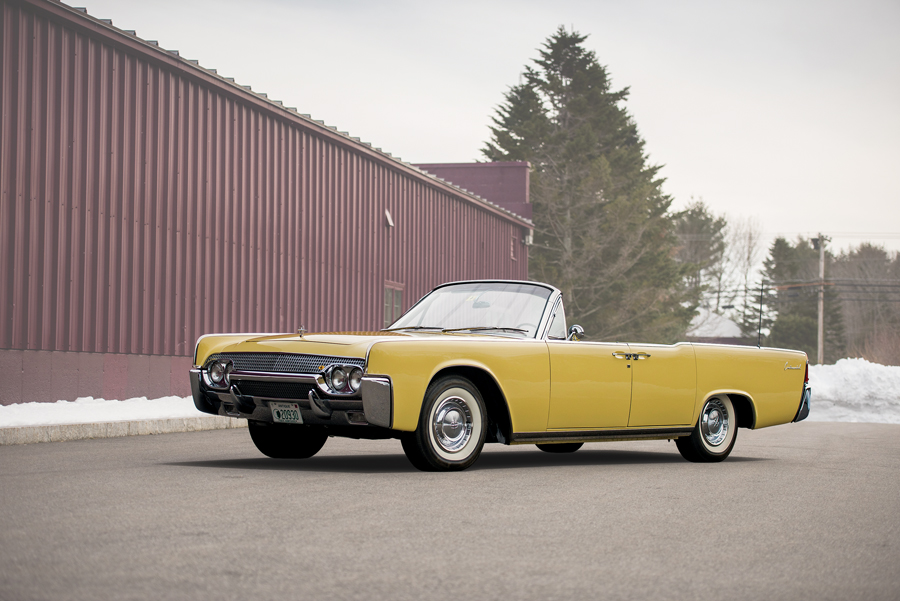SCM Analysis
Detailing
| Vehicle: | 1961 Lincoln Continental convertible |
| Years Produced: | 1961–69 |
| Number Produced: | 2,857 (1961) |
| Original List Price: | $6,713 |
| SCM Valuation: | $36,000 |
| Tune Up Cost: | $350 |
| Chassis Number Location: | Stamped into the right front inner fender apron under the hood |
| Engine Number Location: | Stamped on pad on driver’s side of engine block, forward of cylinder head |
| Club Info: | Lincoln & Continental Owners Club |
| Website: | http://lcoc.org |
| Alternatives: | 1961 Cadillac Sedan de Ville, 1961 Imperial Crown Southampton, 1961 Chrysler 300G convertible |
| Investment Grade: | C |
This car, Lot 909, sold for $103,600, including buyer’s premium, at RM Sotheby’s sale of the Dingman Collection in Hampton, NH, on June 24, 2018.
Some marques seem to always be on the chopping block. The Lincoln division of Ford Motor Company is one of those brands.
Although Lincoln was conceived in 1919 by engineer Henry Leland to build the world’s finest automobile, the company was in receivership by 1922, only to be snatched up by Henry Ford. Thanks to Henry Ford’s eccentricities, Ford’s early Lincolns were often underwhelming and behind the competition in engineering.
Even after Henry’s rule ended, the missteps often continued. Yet there were moments of brilliance, such as the 1941 Continental. Often, those shining examples were the result of management mandates to either save the brand or terminate it. Then, like Texas Hold ’em Poker players, Lincoln designers, engineers and marketing people would push in all their chips with a smashing do-or-die vehicle.
Today’s Continental is one of those save-the-brand luxury machines and has done much to restore Lincoln’s luster. So was the 1961 Continental. After the failures of the 1950s, especially the huge and homely 1958–60 Continentals, the ’61 version was simply an all-or-nothing play — and the gamble paid off.
Understated elegance
The Turquoise Mist Continental on the cover of the March 1961 issue of Car Life magazine was revealing. Contrast the understated elegance of the new Continental with the red Dodge Lancer on the previous month’s cover, a garish exercise in ’50s-style excess brought into the new decade.
Elwood Engel and his team were tasked with creating the Continental’s landmark design, which earned Lincoln the Bronze Medal from the Industrial Design Institute. The only models available were a 4-door sedan and the unusual 4-door convertible, both with rear-opening suicide-style rear doors. Those unique doors were designed to make entry to the rear seats easier and became a defining feature of Continentals from 1961 to 1969.
Plus, the convertible’s cloth top folded completely under a raised deck cover, a design taken from the steel-top Ford Skyliners of 1957–59 — no awkward boot to attach for the Continental owner. Ironically, Engel would leave Ford in the next year to lead Chrysler’s design makeover — guess what the inspiration for the 1964–66 Imperial was.
Beneath the Continental’s skin was an engineering marvel. Harold MacDonald and his engineers simply made no compromises. Under the hood was the largest engine in America at the time: 430 cubic inches of smooth, confident power.
Like the ’58 Lincolns, the new car was based on a unibody architecture. But this Continental was not the hulking behemoth of the previous generation. Instead, the wheelbase was eight inches shorter, 17 inches less in overall length, and more than 300 pounds lighter. Yet great attention was given to even the smallest item, such as the effort of the switchgear and the bearings on the ashtrays.
“Final proof of the company’s confidence in this array of engineering and servicing features is found in the warranty: two years or 24,000 miles, whichever comes first,” wrote Car Life magazine. That was an unprecedented warranty at the time. The magazine concluded, “…here is a car extraordinary — one that is designed to be beautiful and comfortable, and built to be long lived and reliable. In short, this is a car which well deserves the 1961 Car Life Award for Engineering Excellence.”
By all accounts they drove and handled better that the typical luxo-barge of the era. The new Continentals were expensive, at least $500 more than a comparable Cadillac, but Ford felt the Lincoln’s design and engineering were worth the premium.
Luxury and value
Unlike the market’s relentless demand for American muscle, American luxury barely makes an impact. ACC’s 2018 Pocket Price Guide Q3 has the proof — despite just 2,857 4-door convertibles produced in their maiden year, the median price is a meager $36,000. Exceptional examples, though, can get near the $75,000 range. So why did this particular Continental sail past the $100k mark?
Certainly, this is a fine automobile, well restored, and particularly striking in Sunburst Yellow paint. Then there is the aura of being part of the Dingman Collection. The late Michael Dingman was a former executive with Ford Motor Company, and he amassed an amazing collection of the finest Ford, Mercury and Lincoln automobiles. This was actually RM’s third auction of Dingman’s collection, the prior sales taking place in 2006 and 2012. This latest auction specialized in over 500 lots of automobilia, but amid the glitz and glitter of Dingman’s vintage neon signs, this 4-door convertible stood out.
Could a bidding war have caused the successful buyer to push in all the chips and go for the win? Maybe. Rather, I’d like to think bidders finally recognized the significance of these all-in Continentals, and the price reflected it. Very well sold.
(Introductory description courtesy of RM Sotheby’s.)
